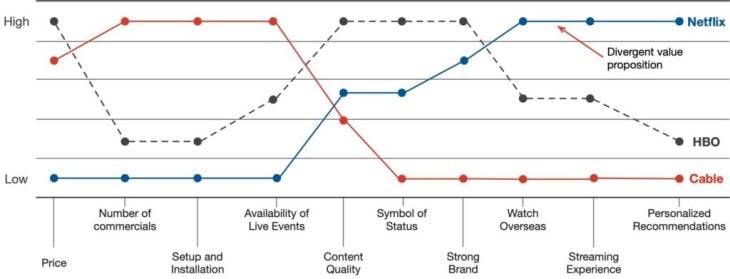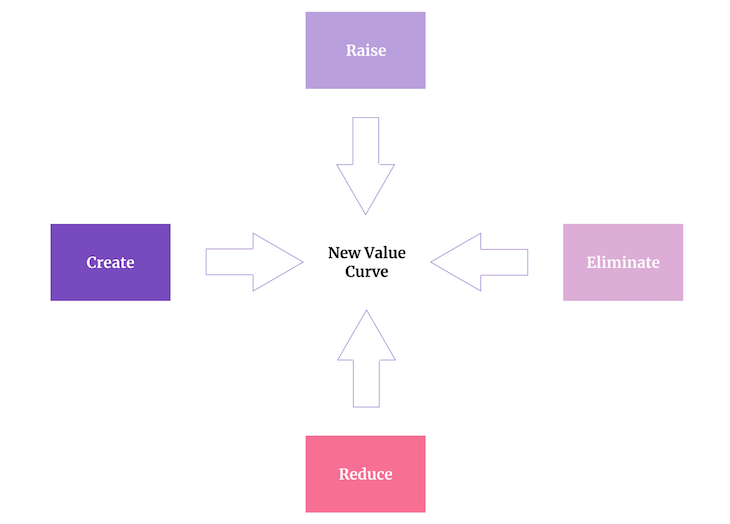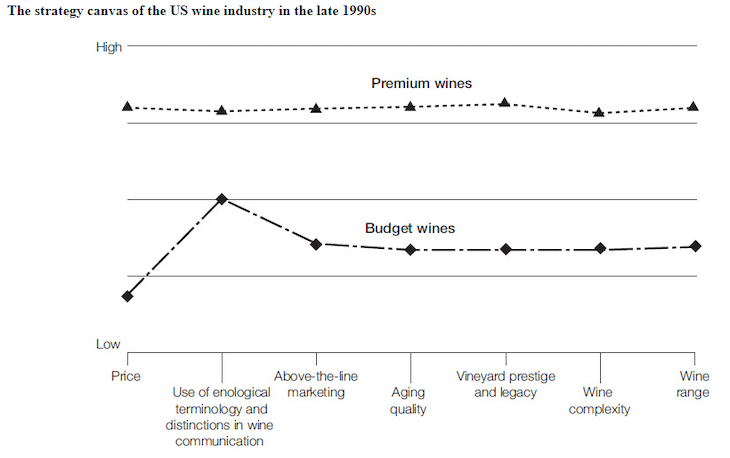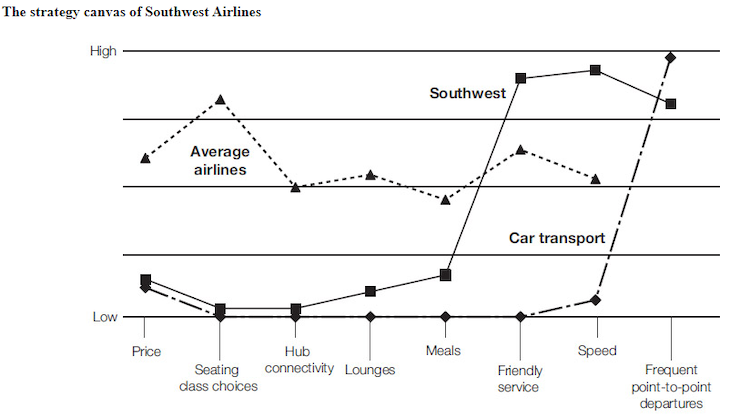Innovators use various techniques and frameworks to build solid business models and win against the competition.
In this guide, we’ll review one of those techniques: the strategy canvas.
You can use a strategy canvas to assess opportunities, evaluate competitors, and even plot a brand new value proposition. Read on to learn what a strategy canvas is and what you can do with it.
- What is a strategy canvas?
- What does a strategy canvas look like?
- What is the four actions framework?
- Strategy canvas examples
- Key takeaways
What is a strategy canvas?
W. Chan Kim first introduced the strategy canvas in his 2014 best-selling book, Blue Ocean Strategy: How to Create Uncontested Market Space and Make Competition Irrelevant.
The primary objective of the canvas was to evaluate so-called “red oceans” — hypercompetitive markets that constantly fight over customers — and find a way to leap into a competition-free “blue ocean.”
However, nothing stops us from using the strategy canvas in a slightly different context. It’s a very versatile tool.
To build a strategy canvas, we need three components:
Players
Players are what we compare.
Although the most common scenario is to use the canvas to compare your product or company with competitors, this tool also works well when comparing whole market categories and looking for gaps between them (we’ll see an example later).
Competing factors
What criteria are most important when making the comparison? While it’s possible to find a hundred interesting factors, focusing on the most critical ones is key.
In the case of product comparison, it’s about understanding what factors are most important for the end users when making a purchase decision.
Say you are buying a car: what’s most essential for you when deciding on a particular model? For many, it would be some combination of the following:
- Price
- Brand
- Speed
- Safety
- Luxury
- Efficiency
Although there are numerous additional factors you might find essential, such as leather seats or a subwoofer, these are unlikely to be your deciding factors. The key is identifying which factors play a critical role in the decision to purchase.
Scores
Now it’s time to score how well each player does in each factor.
Although you want the assessment to be as well-informed as possible, there is no need to be too scientific. It’s all about getting a big picture of who performs how well in which category.
A scale such as 0–6 or 0–10 should be more than enough.
Make sure everyone is on the same page when it comes to assessing negative factors. Say, for example, competitor A scores 6 in terms of price, and competitor B scores 8. Does this mean competitor B has a higher price because of the higher score, or does the score reflect their competitiveness (thus, the price is lower)?
Which way is more “correct” is not worth debating. Ultimately, it’s about ensuring everyone is on the same page when using the framework.
What does a strategy canvas look like?
After deciding who you want to compare, choosing competitive factors, and scoring each player based on these criteria, you can visualize your results in the form of a strategy canvas:

The purpose of the strategy canvas is to lend transparency around:
- Key competitors
- Where they excel
- Where they underperform
A strategy canvas is a living, ever-changing tool. Not only does players’ performance in specific factors change over time, but the whole market changes too. Factors relevant to customers a few years ago might be replaced by other needs today.
What is the four actions framework?
There is a complementary framework to the strategy canvas called the four actions framework.
After mapping the strategy canvas, there are four things you can do to strengthen your value proposition, outcompete others, or even change the game’s rules:
Let’s take a closer look at how you can raise, reduce, create, and eliminate factors on the canvas.
Raise
Which factors can we raise well above the industry’s standards?
If some competitive factors are neglected, it opens up an opportunity to shine over the competition. Even if all the players have an average score of 7 out of 10, aiming to score 10/10 might be a viable idea if that’s one of the deciding factors for a given market.
Keep in mind the “well above the industry’s standards” part. Improving slightly here won’t disrupt the market. The customers might not even notice.
Reduce
Which factors can we reduce well below the industry’s standard?
You might consider ceding some factors to competition and maintaining just the bare minimum.
Why would you intentionally ignore critical factors? One word: resources.
Most companies have a limited budget, headcount, and organizational capacities. Raising standards or addressing new factors is great for driving innovation, but it also consumes even more resources.
Reducing your investment in a few factors will free up resources you can reinvest elsewhere.
Create
Which factors can we create that the industry has yet to offer?
The best way to escape competition is to deliver value in places no one ever thought about.
Surprising the industry by adding brand new factors to the equation is true innovation.
For example, immediate video availability wasn’t something companies were competing to achieve in the 90s. Then, Netflix decided to put a new factor on the table to escape competition and create a new market category: movie streaming.
Eliminate
Which factors that the industry has long competed on should we eliminate?
Adding a new factor often means you need to take something out.
Back to the Netflix example: once it started competing on factors such as video availability, download speed, etc., over time, factors such as shipping costs and inventory became irrelevant.
Also, the more competitive factors you focus on, the lower your focus, and the lower the chance of dominating them. Ultimately, it’s better to nail 10 factors that get outcompeted in 20.
Plus, there’s no better way to free up precious resources than to cede some areas altogether:

Raise and reduce your score in competitive factors to adjust and optimize your value proposition and outcompete the market.
Create and eliminate factors to innovate and change the rules of the game.
Strategy canvas examples
To illustrate how to use strategy canvas and the four actions framework, let’s look at two real-world examples:
[yellow tail]
[yellow tail] is a wine producer that had problems catching up with competitors in the 90s. At the time, the industry was dominated by two categories of wines: expensive, high-quality brands and cheaper, budget versions.

After doing some research, [yellow tail] realized that there’s a group of customers whose needs aren’t met by either category: young adults. This cohort doesn’t care much about brand, prestige, or complexity; it’s more concerned with simplicity, such as ease of drinking and selection.
Based on these insights, [yellow tail] decided to:
- Eliminate — Aging qualities, above-the-line marketing, and enological terminology and distinctions only confused young adults
- Reduce — Wine complexity, range, and vineyard prestige, while still relevant, are not critical factors
- Create — Ease of drinking and selection instilled a sense of fun and adventure, which was an unmet need of young adults
- Raise — Price versus budget wines; [yellow tail] determined that its target customers’ willingness to pay was higher than for budget wines
![Strategy Canvas Example: [yellow-tail]](https://blog.logrocket.com/wp-content/uploads/2022/11/strategy-canvas-example-yellow-tail.png)
Southwest Airlines
Southwest Airlines found out there are two types of customers: one that preferred fast airlines and one that favored the cheapness and flexibility of a car. The airline thus embarked on a mission to combine them both.
Based on this insight, Southwest decided to:
- Reduce — Seating choices, hub connectivity, lounges comfort, and meals option, all to reduce the total price, which was a core factor
- Increase — Overall speed of transport from point A to B (among others, thanks to reduced hub connectivity and seating choices) and friendliness of service to make the value proposition even more compelling
- Create — Departure frequency, almost matching the flexibility of a car

As a result, Southwest established a new category of air travel — one that is cheap, fast, and flexible but offers lower travel comfort than traditional airlines.
Key takeaways
The strategy canvas and the accompanying four actions framework are powerful tools that can be used, among other purposes, to:
- Map and compare competitors
- Look for cross-industry inspiration (like Southwest Airlines)
- Evaluate different market categories (like [yellow tail])
- Plan and hypothesize value proposition
Use the strategy canvas either as a one-time planning exercise or a long-lived monitoring artifact. While it’s a rather uncommon technique, especially compared to more popular frameworks such as the value proposition or lean UX canvas, it can provide invaluable insights.
The post What is a strategy canvas and how to create one (with examples) appeared first on LogRocket Blog.
from LogRocket Blog https://ift.tt/5bmhNg3
Gain $200 in a week
via Read more



